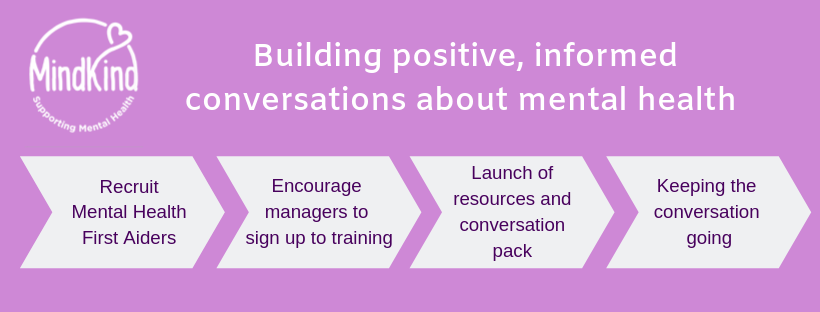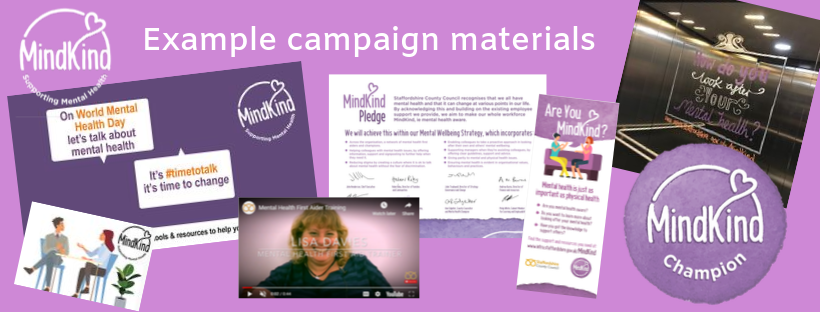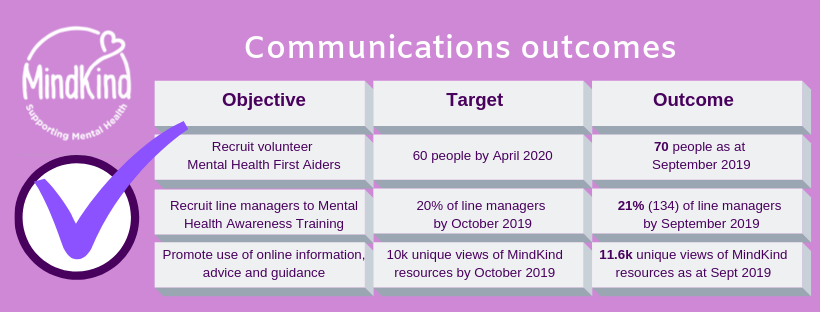This short case study outlines how the council has combined excellent internal communications with a strong health and wellbeing offer to create an environment where people feel better able to manage their mental health.
Staffordshire County Council is committed to tackling the stigma that mental health can carry by educating colleagues around mental health issues and offering practical advice and support.
As a result, the council has seen absence due to psychological reasons reduce by 2.9 per cent and has seen a 43 per cent return on their investment to date.
The challenge
Mental illness effects 1 in 4 of us during our adult lives. The impacts of it can be wide-ranging and sometimes devastating, but with the right tools, support and/or medication, people can live their lives to the full.
Mental health was the top reason for staff absence at Staffordshire County Council in 2018.
Whilst 73 per cent of county council employees felt that the council was a ‘great place to work’, like many others working in local government, colleagues were experiencing a significant level of change, with the organisation facing tough financial challenges.
A survey completed by 411 colleagues suggested that most people (82 per cent) took steps to look after their mental health, but qualitative research suggested embarrassment, fear (both from managers and employees around saying or doing the ‘wrong thing’) and concerns about job security made mental health a difficult issue for people to navigate.
In recognition of this, as part of their People Strategy (which sets out how they will develop the right culture, environment, skills and leadership qualities to keep making a difference for Staffordshire’s communities in the future), the county council committed to tackling the stigma that mental health can carry by educating colleagues around mental health issues and offering practical advice and support.
The solution
Building positive, informed conversations about mental health
The MindKind conversation has been supported with four main blocks of communications activity.
1. Recruitment of Mental Health First Aiders
Recruiting and training Mental Health First Aiders (MHFAs) at the outset provided us with a knowledgeable and willing team to lead positive conversations across the organisation.
We used a range of internal channels to recruit volunteers - Business Brief (a monthly webinar briefing for senior leaders), Team Talk (a monthly team briefing pack for managers), email updates and intranet news articles. As an outward sign of commitment and to make them visible to others, our MHFAs were awarded a purple MindKind lanyard.
2. Recruitment to management training
We made a conscious decision not to make the management training mandatory as being MindKind is not about force, but about belief and a will to do the right thing. We supplemented recruitment communications in our usual internal channels with a simple social norming technique, giving those who had completed their training a small pin badge to wear as a signal of their personal commitment and to encourage the same in their peers.
3. Launch of MindKind resources and conversation pack
The MindKind brand was developed in-house, with input from our MHFAs, to set the right tone for the conversation, give it visibility and provide a link to our ThinkWell counselling service, which provides up to six counselling sessions for council colleagues to support their mental wellbeing.
The launch, which coincided with World Mental Health Day 2018, included the creation and promotion of a trusted online source of advice and guidance to reinforce the work of our MHFAs and line managers. This included a short educational video as well as a conversation pack for managers.
Conversation starters – such as a surprise piece of artwork drawn onto the mirror in the lift – cost us nothing, but got people talking and our MHFAs made themselves visible and available for people to speak to.
Key messages included:
- that we all have mental health
- that mental health problems are common and can happen to anyone
- that I can look after my mental health in the same way that I can look after my physical health
- I can speak to my line manager or a Mental Health First Aider for support or find out more on the intranet
4. Keeping the conversation going
Our focus has now shifted to ongoing content management to keep the conversation going - video testimonials from colleagues, the Sleep Challenge and MindKind bingo are just a few examples of this. We also welcomed ex-Liverpool FC footballer, Chris Kirkland, to talk openly with colleagues about his mental health experiences. This proved popular with male colleagues and ‘sold out’ within days.
The impact:
Communications outcomes
Organisational impact
Our total investment in the campaign and training (not including staff time) to date has been £24,450 and despite an upwards trend in absence figures and a significant period of change across the council, initial figures show that we have reduced absence related to mental ill health by 2.9 per cent in 2018/19.
All those who have taken part in the mental health awareness training agree that they are now more confident in having a conversation related to mental health.
This is a promising foundation for the future. Not only does it suggest that our people are feeling better able to manage issues related to mental health, the £35,000 saving to the council in the equivalent cost of statutory sick pay represents a 43 per cent return on investment.
What’s more, evaluation thus far only takes into account the cost of sickness pay and not any reduction in presenteeism that runs hand in hand with better metal wellbeing.
Changing attitudes and behaviours takes time, but we are heartened by what we have achieved in the first 12 months and look forward to building on what we’ve learned in the future.
Why it worked and how we're sustaining it
“Conversation is the smallest unit of change”.
Long term culture and behavioural change is difficult.
As communicators, our primary role is around persuasion and education, winning the “hearts and minds” of colleagues so that they believe in proactively looking after their mental health and know how to do it.
Working in close partnership with our health and safety team, our strategy centred on facilitating informed, positive and ongoing conversations about mental health across the organisation.
A focus on conversation rather than cascade has allowed us to approach the issue with genuine sensitivity, creating a culture of support that reaches far beyond the end of the campaign budget.
An army of internal ‘influencers’ now lead the conversation. Line managers have been critical to this, given that they account for two-thirds of the impact on employees’ attitudes and behaviour, but peer-to-peer support through our Mental Health First Aiders is also important, providing a trusted ‘neutral’ source of support for those who feel that they cannot speak openly with a manager.
Lessons learned
The county council covers a geographical area of 1000 square miles and whilst just over a third of staff are based in Staffordshire Place One (our headquarters), others are based across almost 90 different sites. Our Smart Working initiative also means that colleagues are more frequently working from home or a location other than an office. If we were to do anything differently, we would want to out more focus into facilitating positive conversations around mental health with remote workers and ensure a greater representation of Mental Health First Aiders from sites across the county in the early days of the campaign.
Contact: Sarah James, Campaigns and Internal Communications Manager
[email protected]



